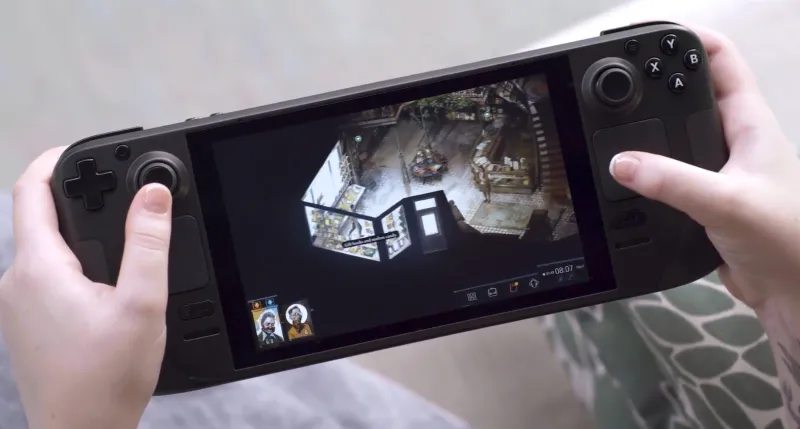
Steam branding is strong. Valve Corporation has turned their third-party marketplace into the first place millions choose to buy their PC games. The service has seen record-breaking numbers earlier this year with over 25 million concurrent users, so whatever they are doing is clearly working. Yet with all those software sales, last month Valve announced a new piece of hardware they call the Steam Deck.
Use the colloquialism you’d like, “not resting on your laurels” or “Mamba Mentality”, it’s not as if competitors in the handheld PC space are boasting ludicrous sales numbers. At their core, Valve is in the business of selling computer games. So why venture into making hardware?
One of the first things that (Valve) are often asked by people whenever we’ve told people we’re creating a new controller is, “Why?” There’s a bunch of good dual analog stick controllers out there…unfortunately in the PC space most games weren’t designed to work with a traditional controller.
Scott Dalton, GDC 2016 Presentation
Where Did All That Steam Come From?
Valve’s first commercial attempt in the world of hardware development came in the form of the “Steam Machines” branding. Valve partnered with established PC hardware manufacturers in 2013 in order to create a common set of specifications for gaming PC builds. The specs amounted to good, better, or best. Three options that sought to simplify PC gaming albeit with one major issue, SteamOS. Valve customized a version of Debian Linux with the same approach Ray did in Field of Dreams, “If you build it, (the games) will come”. They didn’t. The better part of a decade later it is still the exception, rather than the rule, that PC games receive ports to Linux.

A couple years later, Valve flirted with the idea that PC games should be on TV. This idea took the physical form of the Steam Link and Steam Controller. The tandem of devices, when paired with a proper gaming PC, would allow users to remotely play their game libraries on any TV in the house. If both the PC and Steam Link were hardwired into ethernet, the experience was generally pretty good. If left alone with WiFi, it was a decidedly worse experience (because everybody’s WiFi sucks). Though the legacy of this hardware excursion for Valve was summed up by the day they liquidated their inventory in 2019 for five bucks a pop. That’s why Steam Link is just an app now.
Valve was working on virtual reality tech as early as 2012, but opted to partner with smartphone manufacturer HTC for a commercial VR headset in 2016. The rhetoric surrounding VR at the time was as if the word saccharine had extra sugar on top. Tastes would sour on VR when the people counting the number of virtual shooting galleries ran out of fingers. The market stagnated. Lessons learned there obviously led to Valve creating their own product (Valve Index) a few years later, so the story of Valve in VR has yet to be written. However, the most telling statistic may be that only about a quarter of VR headsets connected to Steam are one of theirs.
What If You Get The Steam On Your Hands?

The concept of a portable gaming device is more than proven. Nintendo’s history of handhelds has seen over a half billion served, so it’s no wonder Valve saw an opportunity with a handheld of their own. The Steam Deck is a foot long slab with four core AMD Zen 2 APU, 16 GB of DDR5 RAM, on a seven inch 1280×800 IPS display wrapped with the full suite of controller buttons. All that for an entry price of $399. What’s not to like?
For one, the Steam Deck ships with SteamOS 3.0 which is based on Arch Linux. Open source software is something to be celebrated in most scenarios, but the reality of gaming on Linux has been more famine than feast. Valve plans to remedy that situation with their compatibility tool, Proton. This software acts as a translation layer between Windows API calls into portable operating system interface calls via Wine, another tool many Linux users are all too familiar with. It means that Valve is no longer waiting for developers to bring native ports to Linux, and just as with human language translations some goofiness is to be expected. An independent group of software testers outside Valve have compiled a database of Proton’s performance, and the results speak for themselves. It’s way better than how games used to be on Linux, but it is still early days yet.
Valve has been refreshingly open by letting potential customers know they can install an alternative OS on the Steam Deck. Multiplayer game enthusiasts will certainly want to take advantage. Many of the anti-cheat services that run in the background with games like PUBG and Fortnite do not currently work on SteamOS. A Windows install would solve that, however, while readers of Hackaday are no stranger to creating bootable media the truth is most players will stick with the default.
By this writer’s estimation the Steam Deck represents Valve’s third major push into designing their own hardware. Previous efforts like the Steam Controller are commendable for their audacity to “reinvent the wheel”. The Index VR headset design is widely considered best in class. Though it would be remiss not to note the strange relationship Valve has always had with the number three. If you ever needed convincing of this phenomena…just ask Gordon Freeman.
For more on Valve Software’s history, check out this article on the company’s VR and AR prototypes.
[Main image source: Steam Deck]
0 Commentaires